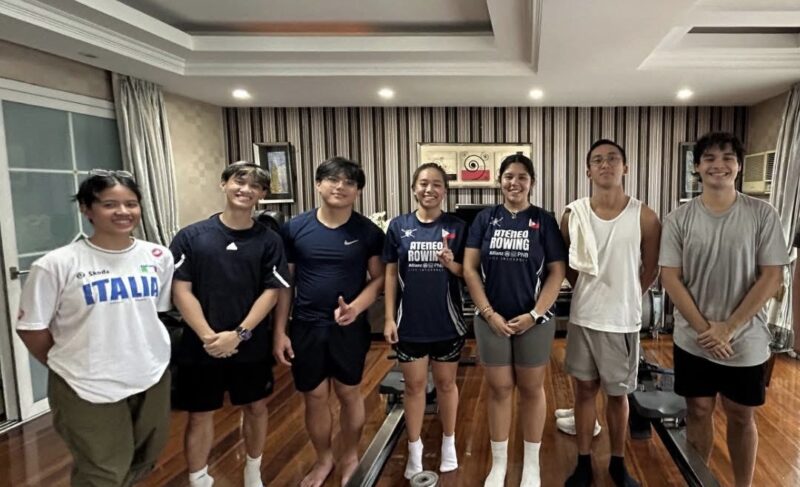Community spaces build and nurture human connections. However, when physical and economic barriers make these spaces inaccessible, more people become alienated.
AMID THE domineering grays characterizing Metro Manila’s cityscape, long-coveted dots of green have become rare novelties. Instead, marking the wide stretch of Katipunan are condominiums, restaurants, fast food chains, cafes, and bars.
Sociologist Ray Oldenburg calls places like these “third places,” as they function as settings for human connection. However, staying in these spaces demand patronage—something which cannot always be given.
Inexpensive third places, such as parks, are limited. Most often, these third places are also situated within other institutions, prompting critical conversations about the accessibility of such communal spaces. For now, Katipunan’s gated campuses offer much-needed succor from the chaos of urbanity—but priority must be placed on letting green places exist without borders as a step toward a more people-friendly environment.
Greener grass
When it is not too hot outside, Lukas Plastina (1 AB COM) finds it common to see Ateneans sprawled out on colorful mats in the amphitheater of Areté. The area, which is a combination of neatly-trimmed grass and unique art installations, has become a place for students to bond and enjoy each other’s company.
“I remember in the first week of college, my first time in Areté was with my blockmates, and [we were] just running around on the grass,” Lukas shares.
Lukas, who grew up in Dasmariñas, Cavite, is an appreciator of green spaces. Growing up, their garden used to be a space where he could read or play tag with his friends. Meanwhile, the parks near him became areas where he and his family can rest when biking.
Lukas’s inclination toward such spaces eventually influenced his decision to enroll miles away from home. “This kind of space is very important to me, because it’s just very refreshing to see green that isn’t man-made,” he explains.
However, such spaces remain limited, especially amid the bustling cityscape, where most green spaces hide behind gated subdivisions and exclusive campuses. “You step out of Ateneo and all you see are […] lots of cars that are very loud—and it’s really quite unfortunate that these [green spaces] are not accessible to a lot of people,” he says.
Also growing up in Cavite, AD Macarubbo (1 AB POS) vividly recalls how her General Trias neighborhood housed vacant lots that became community spaces. The people valued such areas that a large, unclaimed plot of land in her village was converted into a bike trail. “Grass lang talaga siya sa una, pero because people bike there frequently, nagkaroon na siya ng pathway for bikes (It was really just grass at first, but because people bike there frequently, pathways for bikes were created),” she narrates.
Carrying this narrative, AD believes that inclusive projects like bike trails help build communities, and that being truly present in communal areas can encourage an individual to socialize with others.
Level ground?
While third places have the ability to weave people together and give them a sense of belongingness, not all of these spaces are created equal. Unfortunately, socioeconomic status factors into the way these spaces are enjoyed and experienced.
Blue Mobility Vice President for Social Innovations Joshua Angelo Dy (4 AB DS) perceives a sense of exclusivity about third places in the country, which he attributes to the predominance of the private sector in spatial distribution.
“Access [to] third places in the Philippines, particularly in Manila, is a bit uneven in the sense that it is only those with the capital and resources that can access third places more frequently. Think about how many people can access malls, restaurants, even cafes—those things demand money and resources,” he expresses.
On a similar note, AD suggests that people’s inclination toward the private sector harms opportunities for building more inclusive third places. “Usually ‘yung vacant lot [ng business owners], gagawin nilang building nila talaga. Walang nag-o-opt na ‘yung business nila, gagawing parang into a more open, green space,” she shares.
(Business owners usually convert their vacant lot into buildings. No one opts to make their businesses greener and more open.)
As a result of the consumerist culture underlying third places, many people are faced with an invisible barrier that hinders them from fully enjoying places supposedly open to all.
“We don’t have parks, we don’t have any recreational places for activities, except campus of course, [but] if you’re not a student [in the Ateneo] then where will you go?” AD adds.
Given such hurdles, individuals from lower socioeconomic statuses often have limited options for leisurely spaces, aside from public third places such as cafés and malls. Unfortunately, the inclusive facades of such spaces often belie the reality of their inhospitality.
“There are a lot of public third spaces, but those tend to be surveillance-heavy. They tend to police users and discriminate against vendors. They tend to be hostile to those in the lower levels,” Joshua shares.
On top of this, Joshua laments his observation that many of the country’s public third places are not being developed to their maximum potential. In some cases, these spaces are even left in a state of disrepair.
The road ahead
Amid the glaring disparities between the way people from different socio-economic classes experience third places, making these spaces enjoyable for all can only be made possible with the entwinement of spatial connectivity and social connection. For Joshua, the more connected our mobility systems are, the more integrated we become with our environments, the institutions we engage with, and with one another.
To strengthen the ties that bind individuals both to their spaces and to one another, Joshua proposes the democratization of third places through mobility. This movement includes going against car-centrism by opening up roads to people who use different modes of transportation.
Given Metro Manila’s unrivaled population density, finding space for inclusive third places can be difficult. Still, a wealth of potential in the roads of the sprawling metro remains untapped, especially for pedestrianization. The possibilities are evident in the success of the car-free Sundays initiative carried out on Ayala Avenue and other neighborhoods.
“Sometimes they’re officiated by the [local governments], but sometimes they’re also not official. It’s just people pedestrianizing the streets on their own because they want their own spaces,” Joshua shares.
These examples display the prospects of exercising resourcefulness in recognizing and reimagining pre-existing public spaces as areas not just to facilitate public transit, but also to serve as alternative third places. In the end, however, the better way to support third places is through engaging with such spaces in person.
“Being able to experience [third places] also lets you empathize with what people are going through—and that’s very useful, because you can use that as part of your voice [to demand] for more inclusive spaces,” Joshua says.
Considering complex technical and political barriers, expecting such visions to materialize and change the established urban planning paradigm may seem far-fetched. Despite this, Dy remains steadfast in his belief that stepping outside of one’s silo and engaging in discussions with other stakeholders are crucial steps toward cultivating more inclusive third places.







